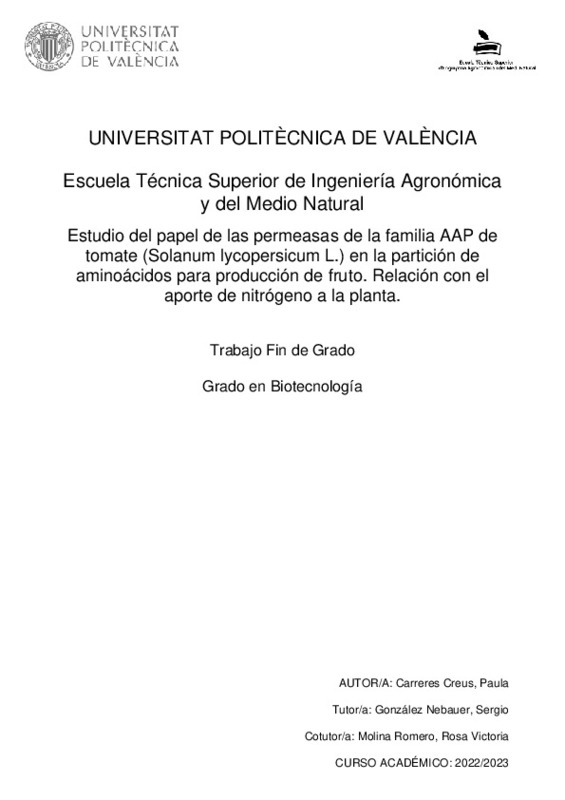|
Resumen:
|
[ES] La familia de permeasas AAP se ha descrito como clave en la partición de aminoácidos en Arabidopsis y cultivos como el guisante o el arroz. Sin embargo, hay muy poca información sobre el papel de las AAPs en especies ...[+]
[ES] La familia de permeasas AAP se ha descrito como clave en la partición de aminoácidos en Arabidopsis y cultivos como el guisante o el arroz. Sin embargo, hay muy poca información sobre el papel de las AAPs en especies de fruto carnoso como el tomate (Solanum lycopersicum L.), principal cultivo de hortalizas a nivel mundial. En este trabajo, se ha realizado una caracterización inicial de las distintas permeasas descritas en tomate, estudiando su expresión génica en distintos órganos, que estaría relacionada con su posible papel en la carga de aminoácidos al floema en hoja, así como en la descarga al fruto. Asimismo, se ha estudiado la variabilidad existente de su expresión en hoja entre cultivares con conocidas diferencias en la eficiencia en el uso del N (NUE), así como el efecto de una reducción de la fertilización nitrogenada.
Con respecto a la carga de aminoácidos en hoja, se ha observado la existencia de variabilidad en la expresión de estas permeasas entre distintas accesiones de tomate. Hay que señalar que, aunque existe variabilidad entre genotipos, las permeasas AAP2 y AAP4 son las que se expresan mayoritariamente en todos ellos, siendo posiblemente las principales responsables de la carga del floema en hoja. En condiciones limitantes de N, cobra especial interés la permeasa AAP6 que presenta un aumento de expresión en todas las accesiones estudiadas. Además, en estas condiciones de cultivo, existe una correlación con la producción y el tamaño de fruto.
El estudio de las permeasas implicadas en la descarga de aminoácidos a las distintas partes del fruto, en la variedad Moneymaker, revela que también en este órgano son las permeasas AAP2 y AAP4 las que se expresan mayoritariamente y, por tanto, aquellas responsables de la descarga del floema al fruto.
En su conjunto, estos estudios preliminares han permitido identificar diversos genes AAPs con funciones relevantes en procesos tanto de carga como descarga de aminoácidos, así como en la respuesta a la deficiencia del nitrógeno. En el contexto actual de necesaria reducción de la aplicación de fertilizantes nitrogenados en agricultura, todos ellos podrían ser dianas de futuros programas de mejora de la NUE.
Los objetivos de este trabajo se relacionan con los siguientes ODS de la Agenda 2030: ODS 6. Agua limpia y saneamiento, ODS 12. Producción y consumo responsables, ODS 14. Vida submarina y ODS 15. Vida de ecosistemas terrestres.
[-]
[EN] The AAP family of permeases has been described as key in the partitioning of amino acids in Arabidopsis and crops such as pea or rice. However, little is known about the role of AAPs in fleshy fruit species such as ...[+]
[EN] The AAP family of permeases has been described as key in the partitioning of amino acids in Arabidopsis and crops such as pea or rice. However, little is known about the role of AAPs in fleshy fruit species such as tomato (Solanum lycopersicum L.), the main vegetable crop worldwide. In this work, an initial characterization of the different permeases described in tomato has been carried out, studying their gene expression in different organs, which would be related to their possible role in the load of amino acids to the phloem in leaves, as well as in the discharge to the fruit. Likewise, the existing variability of its expression in leaves among cultivars with known differences in N use efficiency (NUE), as well as the effect of a reduction in nitrogen fertilization, has been studied.
Regarding the load of amino acids in leaves, the existence of variability in the expression of these permeases among different tomato accessions has been observed. It should be noted that, although there is variability between genotypes, the AAP2 and AAP4 permeases are the ones that are most expressed in all of them, possibly being the main responsible for the phloem load in leaves. Under limiting conditions of N, the AAP6 permease is of special interest, which presents an increase in expression in all the accessions studied. Also, under these growing conditions, there is a correlation with production and fruit size.
The study of the permeases involved in the release of amino acids to the different parts of the fruit, in the Moneymaker variety, reveals that the AAP2 and AAP4 permeases are also the most expressed in this organ and, therefore, those responsible for the release from phloem to fruit.
Taken together, these preliminary studies have allowed the identification of various AAPs genes with relevant functions in processes of both loading and unloading of amino acids, as well as in the response to nitrogen deficiency. In the current context of necessary reduction in the application of nitrogenous fertilizers in agriculture, all of them could be targets of future improvement programs of the NUE.
The objectives of this work are related to the following SDGs of the 2030 Agenda: SDG 6. Clean water and sanitation, SDG 12. Responsible consumption and production, SDG 14. Life below water and SDG 15. Life on land.
[-]
|








